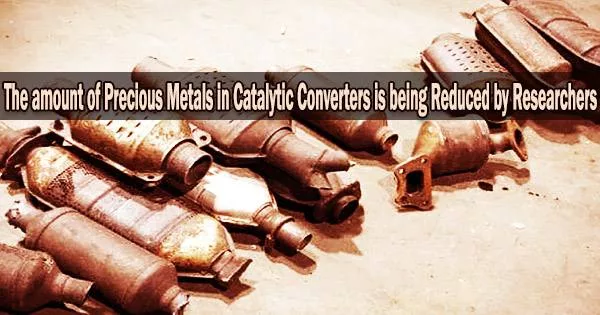Because they contain valuable metals like platinum, palladium, and rhodium, catalytic converters are desirable targets for thieves. However, scientists at the University of Central Florida are attempting to increase their effectiveness while minimizing the amount of precious metals needed in them.
Catalytic converters, which use precious metals as catalysts to help remove deadly chemicals from combustion engine exhaust, were widely adopted in the 1970s. The cost of precious metals has risen along with the quantity of stolen catalytic converters.
In order to remove dangerous substances when a vehicle initially begins, UCF researchers recently showed that they could employ atomic platinum to manage emissions and operate the system at lower temperatures. These studies, which were published in Nature Communications and the Journal of the American Chemical Society, respectively, were published in recent months.
Fine-tuning Platinum Atom Location
In the Nature Communications study, UCF research teams led by Fudong Liu, assistant professor in the Department of Civil, Environmental and Construction Engineering, and Talat Rahman, distinguished Pegasus Professor in the Department of Physics, successfully constructed platinum single atoms with different atomic coordination environments at specific locations on ceria. Ceria is a metal oxide that helps improve catalytic reaction performance.
We showed how to control and utilize the structures of metal single-atom, atomic single-layer, and cluster sites in emission control related reactions, and how to understand their structure-performance relationship using both experimental and theoretical simulation approaches. This will pave the way for future environmental catalyst design at the atomic level and achieve high efficiency in practical applications.
Fudong Liu
Liu and Rahman are also affiliated with the Catalysis Cluster for Renewable Energy and Chemical Transformations (REACT).
According to the researchers, the platinum atoms displayed remarkably different behaviors in catalytic processes like the oxidation of ammonia and carbon monoxide in a diesel engine exhaust aftertreatment system.
The oxidation changes hazardous ammonia into nitrogen and water molecules as well as lethal carbon monoxide into carbon dioxide.
“Their results suggest that the catalytic performance of single atom catalysts in targeted reactions can be maximized by optimizing their local coordination structures through simple and industrial-scalable strategies,” Liu says.
“By combining electronic structure calculations with state-of-the-art experiments, the Liu and Rahman teams have made a breakthrough that can significantly benefit the heterogenous catalysis community in designing highly efficient single atom catalysts for both environmental and energy related needs,” Liu says.
“We have successfully developed a facile strategy to selectively fine-tune the local coordination environment of platinum single atoms to achieve satisfactory catalytic performance in different target reactions, which will push the understanding of single-atom catalysis a significant step forward,” he says.
Rahman claims that the results of their joint research show how theory and experimentation can be used to reveal microscopic mechanisms that improve catalytic activity and selectivity.
Efficient Carbon Monoxide Oxidation Catalyst
In the Journal of the American Chemical Society study, Liu and collaborators from Virginia Tech and Beijing University of Technology significantly improved the carbon monoxide purification efficiency of a platinum-ceria-alumina catalyst by 3.5 to 70 times compared to the regularly used platinum catalysts.
They achieved this by carefully manipulating the atomic-level coordination structures of platinum on a commercially available ceria-alumina substrate.
“The local structure of the active site within a catalyst determines its catalytic performance,” Liu says. “However, the precise control of the local coordination structure of active sites and the elucidation of intrinsic structure-performance relationships are of great challenges in the heterogeneous catalysis field.”
“We’ve worked to control the local coordination structure of metal sites at an atomic level, develop a highly efficient catalyst in environmental purification related reactions and reveal the structure-performance relationship of the newly fabricated catalysts for guiding the future catalyst design,” he says.
Using a surface defect enrichment strategy, Liu and his team reported the successful fabrication of platinum atomic single-layer and platinum single-atom structures with precisely controlled local coordination environment on ceria-alumina supports.
Using high-angle annular dark-field scanning transmission electron microscopy, one of the key coauthors, Yue Lu from Beijing University of Technology, directly observed that the platinum atomic single-layer and platinum single-atom structures showing 100% metal exposure were embedded into ceria lattice or adsorbed on ceria surface.
The carbon monoxide purification effectiveness of the embedded platinum atomic single-layer site was 3.5 times higher than that of the adsorbed platinum atomic single-layer and ranged from 10 to 70 times higher than that of the platinum single-atom sites.
In collaboration with Hongliang Xin’s research group at Virginia Tech, from both experimental and theoretical aspects, the team concluded that the unique embedded platinum atomic single-layer structure could promote the activation of interfacial oxygen species and thus benefit the carbon monoxide oxidation at low temperatures.
“The work is highly important because it will help the environmental catalysis community better design more active metal catalysts with 100% metal utilization efficiency for targeted environmental applications,” Liu says.
“We showed how to control and utilize the structures of metal single-atom, atomic single-layer, and cluster sites in emission control related reactions, and how to understand their structure-performance relationship using both experimental and theoretical simulation approaches,” Liu says. “This will pave the way for future environmental catalyst design at the atomic level and achieve high efficiency in practical applications.”





